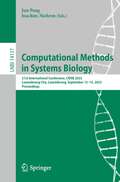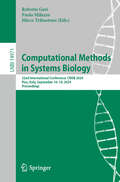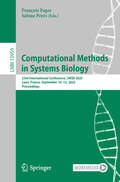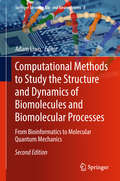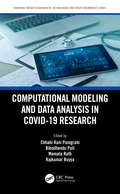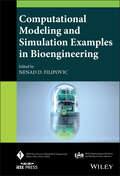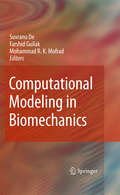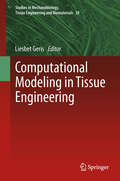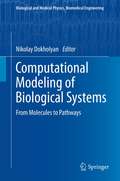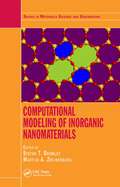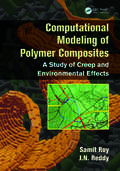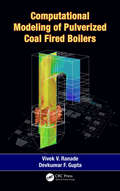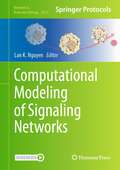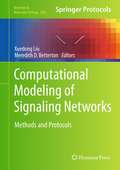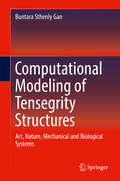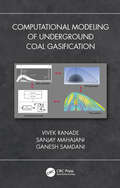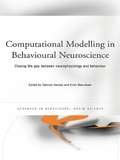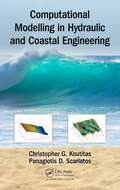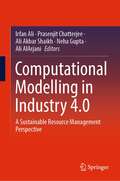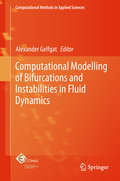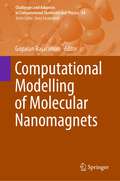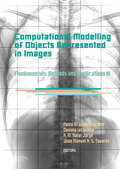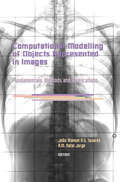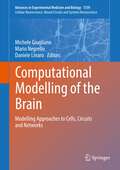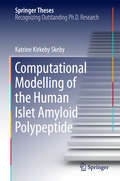- Table View
- List View
Computational Methods in Systems Biology: 21st International Conference, CMSB 2023, Luxembourg City, Luxembourg, September 13–15, 2023, Proceedings (Lecture Notes in Computer Science #14137)
by Jun Pang Joachim NiehrenThis book constitutes the refereed proceedings of the 21st International Conference on Computational Methods in Systems Biology, CMSB 2023, held in Luxembourg City, Luxembourg, during September 13–15, 2023. The 14 full papers and 3 tool papers presented in this book were carefully reviewed and selected from 28 submissions. CMSB focuses on modeling, simulation, analysis, design and control of biological systems and covers the broad field of computational methods and tools in systems and synthetic biology and their applications.
Computational Methods in Systems Biology: 22nd International Conference, CMSB 2024, Pisa, Italy, September 16–18, 2024, Proceedings (Lecture Notes in Computer Science #14971)
by Paolo Milazzo Mirco Tribastone Roberta GoriThis book constitutes the refereed proceedings of the 22nd International Conference on Computational Methods in Systems Biology, CMSB 2024, which took place in Pisa, Italy, during September 16-18, 2024. The 11 full papers included in this book were carefully reviewed and selected from 23 submissions. They deal with computational methods and tools in systems and synthetic biology and their applications, focusing on topics such as modeling and simulation; high-performance methods for computational systems biology; identification of biological systems; applications of machine learning; network modeling, analysis, and inference; automated parameter and model synthesis; model integration and biological databases; multiscale modeling and analysis methods; design, analysis, and verification methods for synthetic biology; methods for biomolecular computing and engineered molecular devices; data-based approaches for systems and synthetic biology; optimality and control of biological systems; modeling, analysis, and control of microbial communities. The conference welcomes new theoretical results with potential applications to systems and synthetic biology, as well as novel applications and case studies of existing methods, tools, or frameworks.
Computational Methods in Systems Biology: 23rd International Conference, CMSB 2025, Lyon, France, September 10–12, 2025, Proceedings (Lecture Notes in Computer Science #15959)
by François Fages Sabine PérèsThis book constitutes the refereed proceedings of the 23rd International Conference on Computational Methods in Systems Biology, CMSB 2025, which took place in Lyon, France, during September 10–12, 2025. The 21 full papers presented in this volume were carefully reviewed and selected from 34 submissions sent to reviews. They are grouped into the following topics: Boolean Networks; Continuous and Hybrid models; Rule-based models; Model inference and machine learning; Population models and control.
Computational Methods to Study the Structure and Dynamics of Biomolecules and Biomolecular Processes: From Bioinformatics to Molecular Quantum Mechanics (Springer Series on Bio- and Neurosystems #8)
by Adam LiwoThis book provides a comprehensive overview of modern computer-based techniques for analyzing the structure, properties and dynamics of biomolecules and biomolecular processes. It is organized in four main parts; the first one deals with methodology of molecular simulations; the second one with applications of molecular simulations; the third one introduces bioinformatics methods and the use of experimental information in molecular simulations; the last part reports on selected applications of molecular quantum mechanics. This second edition has been thoroughly revised and updated to include the latest progresses made in the respective field of research.
Computational Modeling and Data Analysis in COVID-19 Research (Emerging Trends in Biomedical Technologies and Health informatics)
by Chhabi Rani Panigrahi, Bibudhendu Pati, Mamata Rath and Rajkumar BuyyaThis book covers recent research on the COVID-19 pandemic. It includes the analysis, implementation, usage, and proposed ideas and models with architecture to handle the COVID-19 outbreak. Using advanced technologies such as artificial intelligence (AI) and machine learning (ML), techniques for data analysis, this book will be helpful to mitigate exposure and ensure public health. We know prevention is better than cure, so by using several ML techniques, researchers can try to predict the disease in its early stage and develop more effective medications and treatments. Computational technologies in areas like AI, ML, Internet of Things (IoT), and drone technologies underlie a range of applications that can be developed and utilized for this purpose. Because in most cases there is no one solution to stop the spreading of pandemic diseases, and the integration of several tools and tactics are needed. Many successful applications of AI, ML, IoT, and drone technologies already exist, including systems that analyze past data to predict and conclude some useful information for controlling the spread of COVID-19 infections using minimum resources. The AI and ML approach can be helpful to design different models to give a predictive solution for mitigating infection and preventing larger outbreaks. This book: Examines the use of artificial intelligence (AI), machine learning (ML), Internet of Things (IoT), and drone technologies as a helpful predictive solution for controlling infection of COVID-19 Covers recent research related to the COVID-19 pandemic and includes the analysis, implementation, usage, and proposed ideas and models with architecture to handle a pandemic outbreak Examines the performance, implementation, architecture, and techniques of different analytical and statistical models related to COVID-19 Includes different case studies on COVID-19 Dr. Chhabi Rani Panigrahi is Assistant Professor in the Department of Computer Science at Rama Devi Women’s University, Bhubaneswar, India. Dr. Bibudhendu Pati is Associate Professor and Head of the Department of Computer Science at Rama Devi Women’s University, Bhubaneswar, India. Dr. Mamata Rath is Assistant Professor in the School of Management (Information Technology) at Birla Global University, Bhubaneswar, India. Prof. Rajkumar Buyya is a Redmond Barry Distinguished Professor and Director of the Cloud Computing and Distributed Systems (CLOUDS) Laboratory at the University of Melbourne, Australia.
Computational Modeling and Simulation Examples in Bioengineering (IEEE Press Series on Biomedical Engineering)
by Nenad D. FilipovicA systematic overview of the quickly developing field of bioengineering—with state-of-the-art modeling software! Computational Modeling and Simulation Examples in Bioengineering provides a comprehensive introduction to the emerging field of bioengineering. It provides the theoretical background necessary to simulating pathological conditions in the bones, muscles, cardiovascular tissue, and cancers, as well as lung and vertigo disease. The methodological approaches used for simulations include the finite element, dissipative particle dynamics, and lattice Boltzman. The text includes access to a state-of-the-art software package for simulating the theoretical problems. In this way, the book enhances the reader's learning capabilities in the field of biomedical engineering. The aim of this book is to provide concrete examples of applied modeling in biomedical engineering. Examples in a wide range of areas equip the reader with a foundation of knowledge regarding which problems can be modeled with which numerical methods. With more practical examples and more online software support than any competing text, this book organizes the field of computational bioengineering into an accessible and thorough introduction. Computational Modeling and Simulation Examples in Bioengineering: Includes a state-of-the-art software package enabling readers to engage in hands-on modeling of the examples in the book Provides a background on continuum and discrete modeling, along with equations and derivations for three key numerical methods Considers examples in the modeling of bones, skeletal muscles, cartilage, tissue engineering, blood flow, plaque, and more Explores stent deployment modeling as well as stent design and optimization techniques Generates different examples of fracture fixation with respect to the advantages in medical practice applications Computational Modeling and Simulation Examples in Bioengineering is an excellent textbook for students of bioengineering, as well as a support for basic and clinical research. Medical doctors and other clinical professionals will also benefit from this resource and guide to the latest modeling techniques.
Computational Modeling in Biomechanics
by Suvranu De Farshid Guilak Mohammad MofradAvailability of advanced computational technology has fundamentally altered the investigative paradigm in the field of biomechanics. Armed with sophisticated computational tools, researchers are seeking answers to fundamental questions by exploring complex biomechanical phenomena at the molecular, cellular, tissue and organ levels. The computational armamentarium includes such diverse tools as the ab initio quantum mechanical and molecular dynamics methods at the atomistic scales and the finite element, boundary element, meshfree as well as immersed boundary and lattice-Boltzmann methods at the continuum scales. Multiscale methods that link various scales are also being developed. While most applications require forward analysis, e.g., finding deformations and stresses as a result of loading, others involve determination of constitutive parameters based on tissue imaging and inverse analysis. This book provides a glimpse of the diverse and important roles that modern computational technology is playing in various areas of biomechanics including biofluids and mass transfer, cardiovascular mechanics, musculoskeletal mechanics, soft tissue mechanics, and biomolecular mechanics.
Computational Modeling in Tissue Engineering: A Computational Modeling Approach (Studies in Mechanobiology, Tissue Engineering and Biomaterials #10)
by Liesbet GerisOne of the major challenges in tissue engineering is the translation of biological knowledge on complex cell and tissue behavior into a predictive and robust engineering process. Mastering this complexity is an essential step towards clinical applications of tissue engineering. This volume discusses computational modeling tools that allow studying the biological complexity in a more quantitative way. More specifically, computational tools can help in: (i) quantifying and optimizing the tissue engineering product, e.g. by adapting scaffold design to optimize micro-environmental signals or by adapting selection criteria to improve homogeneity of the selected cell population; (ii) quantifying and optimizing the tissue engineering process, e.g. by adapting bioreactor design to improve quality and quantity of the final product; and (iii) assessing the influence of the in vivo environment on the behavior of the tissue engineering product, e.g. by investigating vascular ingrowth. The book presents examples of each of the above mentioned areas of computational modeling. The underlying tissue engineering applications will vary from blood vessels over trachea to cartilage and bone. For the chapters describing examples of the first two areas, the main focus is on (the optimization of) mechanical signals, mass transport and fluid flow encountered by the cells in scaffolds and bioreactors as well as on the optimization of the cell population itself. In the chapters describing modeling contributions in the third area, the focus will shift towards the biology, the complex interactions between biology and the micro-environmental signals and the ways in which modeling might be able to assist in investigating and mastering this complexity. The chapters cover issues related to (multiscale/multiphysics) model building, training and validation, but also discuss recent advances in scientific computing techniques that are needed to implement these models as well as new tools that can be used to experimentally validate the computational results.
Computational Modeling of Biological Systems: From Molecules to Pathways (Biological and Medical Physics, Biomedical Engineering)
by Nikolay V DokholyanComputational modeling is emerging as a powerful new approach to study and manipulate biological systems. Multiple methods have been developed to model, visualize, and rationally alter systems at various length scales, starting from molecular modeling and design at atomic resolution to cellular pathways modeling and analysis. Higher time and length scale processes, such as molecular evolution, have also greatly benefited from new breeds of computational approaches. This book provides an overview of the established computational methods used for modeling biologically and medically relevant systems.
Computational Modeling of Inorganic Nanomaterials (Series in Materials Science and Engineering)
by Stefan T. Bromley Martijn A. ZwijnenburgComputational Modeling of Inorganic Nanomaterials provides an accessible, unified introduction to a variety of methods for modeling inorganic materials as their dimensions approach the nanoscale. With contributions from a team of international experts, the book guides readers on choosing the most appropriate models and methods for studying the stru
Computational Modeling of Polymer Composites: A Study of Creep and Environmental Effects (Applied and Computational Mechanics)
by Samit Roy J.N. ReddyThis book provides a better understanding of the theories associated with finite element models of elastic and viscoelastic response of polymers and polymer composites. It covers computational modeling and life-prediction of polymers and polymeric composites in aggressive environments. It begins with a review of mathematical preliminaries, equations of anisotropic elasticity, and then presents finite element analysis of viscoelasticity and the diffusion process in polymers and polymeric composites. The book provides a reference for engineers and scientists and can be used as a textbook in graduate courses.
Computational Modeling of Pulverized Coal Fired Boilers
by Vivek V. Ranade Devkumar F. GuptaHarness State-of-the-Art Computational Modeling Tools Computational Modeling of Pulverized Coal Fired Boilers successfully establishes the use of computational modeling as an effective means to simulate and enhance boiler performance. This text factors in how computational flow models can provide a framework for developing a greater understanding o
Computational Modeling of Signaling Networks (Methods in Molecular Biology #2634)
by Lan K. NguyenThis volume focuses on the computational modeling of cell signaling networks and the application of these models and model-based analysis to systems and personalized medicine. Chapters guide readers through various modeling approaches for signaling networks, new methods and techniques that facilitate model development and analysis, and new applications of signaling network modeling towards systems and personalized treatment of cancer. Written in the format of the highly successful Methods in Molecular Biology series, each chapter includes an introduction to the topic, lists necessary materials and methods, includes tips on troubleshooting and known pitfalls, and step-by-step, readily reproducible protocols. Authoritative and cutting-edge, Computational Modeling of Signaling Networks aims to benefit a wide spectrum of readers including researchers from the biological as well as computational systems biology communities.
Computational Modeling of Signaling Networks (Methods in Molecular Biology #880)
by Xuedong Liu Meredith D. BettertonSignaling networks are composed of numerous signaling pathways and each has its own intricate component parts. Signaling outputs are dynamic, extraordinarily complex and yet highly specific. In, Computational Modeling of Signaling Networks: Methods and Protocols, expert researchers in the field provide key techniques to study signaling networks. Focusing on Systems of ODEs, parameterization of signaling models, signaling pathways, mass-action kinetics and ODEs, and how to use modeling to plan experiments. Written in the highly successful Methods in Molecular BiologyTM series format, the chapters include the kind of detailed description and implementation advice that is crucial for getting optimal results in the laboratory. Thorough and intuitive, Computational Modeling of Signaling Networks: Methods and Protocols aids scientists in continuing study of how signaling networks behave in space and time to generate specific biological responses and how those responses impact biology and medicine.
Computational Modeling of Tensegrity Structures: Art, Nature, Mechanical and Biological Systems
by Buntara Sthenly GanThis book provides an in-depth, numerical investigation of tensegrity systems from a structural point of view, using the laws of fundamental mechanics for general pin-jointed systems with self-stressed mechanisms. Tensegrity structures have been known for decades, mostly as an art of form for monuments in architectural design. In Computational Modeling of Tensegrity Structures, Professor Buntara examines these formations, integrating perspectives from mechanics, robotics, and biology, emphasizing investigation of tensegrity structures for both inherent behaviors and their apparent ubiquity in nature. The author offers numerous examples and illustrative applications presented in detail and with relevant MATLAB codes. Combining a chapter on the analyses of tensegrity structures along with sections on computational modeling, design, and the latest applications of tensegrity structures, the book is ideal for R&D engineers and students working in a broad range of disciplines interested in structural design.
Computational Modeling of Underground Coal Gasification
by Vivek V. Ranade Sanjay M Mahajani Ganesh Arunkumar SamdaniThe book deals with development of comprehensive computational models for simulating underground coal gasification (UCG). It starts with an introduction to the UCG process and process modelling inputs in the form of reaction kinetics, flow patterns, spalling rate, and transport coefficient that are elaborated with methods to generate the same are described with illustrations. All the known process models are reviewed, and relative merits and limitations of the modeling approaches are highlighted and compared. The book describes all the necessary steps required to determine the techno-economic feasibility of UCG process for a given coal reserve, through modeling and simulation.
Computational Modelling in Behavioural Neuroscience: Closing the Gap Between Neurophysiology and Behaviour (Advances in Behavioural Brain Science)
by Dietmar Heinke Eirini MavritsakiClassically, behavioural neuroscience theorizes about experimental evidence in a qualitative way. However, more recently there has been an increasing development of mathematical and computational models of experimental results, and in general these models are more clearly defined and more detailed than their qualitative counter parts. These new computational models can be set up so that they are consistent with both single neuron and whole-system levels of operation, allowing physiological results to be meshed with behavioural data – thus closing the gap between neurophysiology and human behaviour. There is considerable diversity between models with respect to the methodology of designing a model, the degree to which neurophysiological processes are taken into account and the way data (behavioural, electrophysiological, etc) constrains a model. This book presents examples of this diversity and in doing so represents the state-of-art in the field through a unique collection of papers from the world's leading researchers in the area of computational modelling in behavioural neuroscience. Based on talks given at the third Behavioural Brain Sciences Symposium, held at the Behavioural Brain Sciences Centre, University of Birmingham, in May 2007, the book appeals to a broad audience, from postgraduate students beginning to work in the field to experienced experimenters interested in an overview.
Computational Modelling in Hydraulic and Coastal Engineering
by Christopher Koutitas Panagiotis D. ScarlatosComputational simulation methods have a range of applications in hydraulic and coastal engineering. This textbook provides an introductory but comprehensive coverage of these methods. It emphasizes the finite differences method with applications in reservoir management, closed-conduit hydraulics, free-surface channel flows, surface gravity waves, groundwater movement and mass transport processes. It focuses on applications rather than lengthy theories or derivations of complex formulas and is supported by a wealth of hands-on numerical examples, PowerPoint presentations, learning assignment projects and quizzes.
Computational Modelling in Industry 4.0: A Sustainable Resource Management Perspective
by Ali Akbar Shaikh Irfan Ali Neha Gupta Prasenjit Chatterjee Ali AlArjaniThis book addresses the different problems, practices, challenges and opportunities in sustainable resource management with the help of decision-making techniques to showcase the relevance of computational modelling approaches in sustainable management and Industry 4.0. It aims to address the inherent complexity of managing ecosystems, particularly with respect to involvement of multi-stakeholders, lack of information and uncertainties. Critical analyses are made to point out the need for, and propose a call to, a new way of thinking about sustainable resource management. This book will be useful for academicians, researchers, and industrialists in the field of industrial and production engineering.
Computational Modelling of Bifurcations and Instabilities in Fluid Dynamics (Computational Methods in Applied Sciences #50)
by Alexander GelfgatInstabilities of fluid flows and the associated transitions between different possible flow states provide a fascinating set of problems that have attracted researchers for over a hundred years. This book addresses state-of-the-art developments in numerical techniques for computational modelling of fluid instabilities and related bifurcation structures, as well as providing comprehensive reviews of recently solved challenging problems in the field.
Computational Modelling of Molecular Nanomagnets (Challenges and Advances in Computational Chemistry and Physics #34)
by Gopalan RajaramanThis book summarizes the state-of-the-art advances in the area of computational modelling of molecule-based magnets. Nowadays, various computational tools based on DFT, ab initio methods and other techniques are gaining attention in molecular nanomagnets and are successfully used to solve several outstanding problems in this area. This contributed volume discusses the theoretical foundation of the modelling of molecular magnets, starting from fitting the experimental magnetic data of very large molecules to the theory of pseudo-spin Hamiltonian approach and spin-phonon relaxations mechanisms, while it also presents examples of contemporary applications of both transition metal and lanthanide molecular magnets. In addition, the transport characteristics of molecules when placed at an interface and how these assemble on surfaces are also reviewed. This book is a great tool for researchers working in the fields of molecular magnetism and computational/theoretical chemistry and will also benefit graduate students specializing in physical-inorganic chemistry and molecular modelling.Chapter 6 is available open access under a Creative Commons Attribution 4.0 International License via link.springer.com.
Computational Modelling of Objects Represented in Images III: Fundamentals, Methods and Applications
by Paolo Di Giamberardino & Daniela Iacoviello R.M. Natal Jorge & João Manuel R.S. TavaresComputational Modelling of Objects Represented in Images: Fundamentals, Methods and Applications III contains all contributions presented at the International Symposium CompIMAGE 2012 - Computational Modelling of Object Presented in Images: Fundamentals, Methods and Applications (Rome, Italy, 5-7 September 2012). The contributions cover the state-o
Computational Modelling of Objects Represented in Images. Fundamentals, Methods and Applications: Proceedings of the International Symposium CompIMAGE 2006 (Coimbra, Portugal, 20-21 October 2006) (Lecture Notes In Computer Science / Image Processing, Computer Vision, Pattern Recognition, And Graphics Ser.)
by João Manuel R.S. Tavares R.M. Natal JorgeThis book contains keynote lectures and full papers presented at the International Symposium on Computational Modelling of Objects Represented in Images (CompIMAGE), held in Coimbra, Portugal, on 20-21 October 2006. International contributions from nineteen countries provide a comprehensive coverage of the current state-of-the-art in the fields of: - Image Processing and Analysis; - Image Segmentation; - Data Interpolation; - Registration, Acquisition and Compression; - 3D Reconstruction; - Objects Tracking; - Motion and Deformation Analysis; - Objects Simulation; - Medical Imaging; - Computational Bioimaging and Visualization. Related techniques also covered in this book include the finite element method, modal analyses, stochastic methods, principal and independent components analyses and distribution models. Computational Modelling of Objects Represented in Images will be useful to academics, researchers and professionals in Computational Vision (image processing and analysis), Computer Sciences, and Computational Mechanics.
Computational Modelling of the Brain: Modelling Approaches to Cells, Circuits and Networks (Advances in Experimental Medicine and Biology #1359)
by Mario Negrello Michele Giugliano Daniele LinaroThis volume offers an up-to-date overview of essential concepts and modern approaches to computational modelling, including the use of experimental techniques related to or directly inspired by them. The book introduces, at increasing levels of complexity and with the non-specialist in mind, state-of-the-art topics ranging from single-cell and molecular descriptions to circuits and networks.Four major themes are covered, including subcellular modelling of ion channels and signalling pathways at the molecular level, single-cell modelling at different levels of spatial complexity, network modelling from local microcircuits to large-scale simulations of entire brain areas and practical examples. Each chapter presents a systematic overview of a specific topic and provides the reader with the fundamental tools needed to understand the computational modelling of neural dynamics. This book is aimed at experimenters and graduate students with little or no prior knowledge of modelling who are interested in learning about computational models from the single molecule to the inter-areal communication of brain structures. The book will appeal to computational neuroscientists, engineers, physicists and mathematicians interested in contributing to the field of neuroscience.Chapters 6, 10 and 11 are available open access under a Creative Commons Attribution 4.0 International License via link.springer.com.
Computational Modelling of the Human Islet Amyloid Polypeptide (Springer Theses)
by Katrine Kirkeby SkebyThis thesis offers readers a comprehensive introduction to amyloid proteins and the computational methods used with them. Katrine Skeby critically assesses and compares both the literature and the experiments performed by other researchers, which further elevates the quality and relevance of her own work. Amyloid proteins are highly complex, and this research provides unparalleled insights, especially with regard to the origin of cytotoxicity and to developing technologies for early detection, revealing in detail the molecular mechanisms behind hIAPP behavior. Several studies within the thesis answer difficult questions which promote future research into the properties of amyloid proteins.
